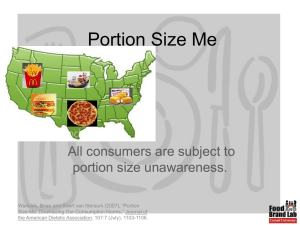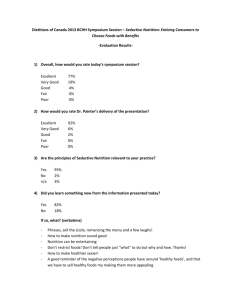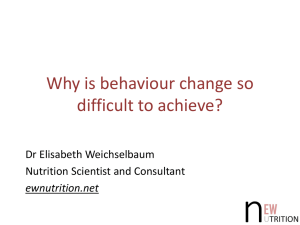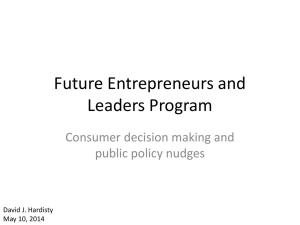CALS COURSE PROPOSAL
advertisement
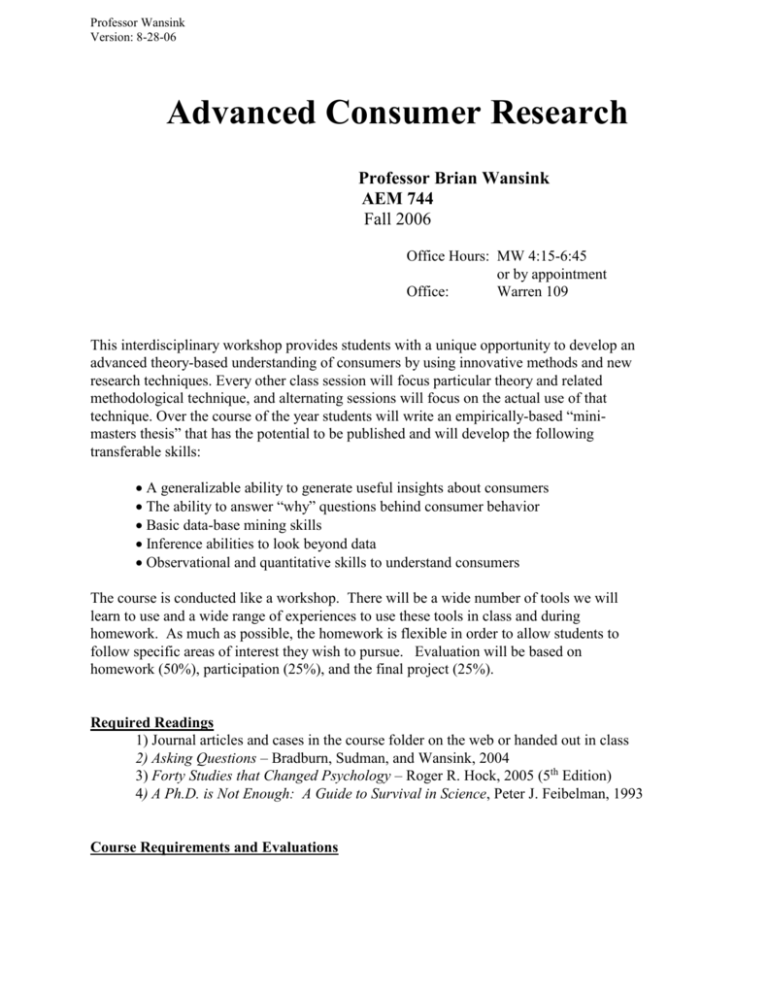
Professor Wansink Version: 8-28-06 Advanced Consumer Research Professor Brian Wansink AEM 744 Fall 2006 Office Hours: MW 4:15-6:45 or by appointment Office: Warren 109 This interdisciplinary workshop provides students with a unique opportunity to develop an advanced theory-based understanding of consumers by using innovative methods and new research techniques. Every other class session will focus particular theory and related methodological technique, and alternating sessions will focus on the actual use of that technique. Over the course of the year students will write an empirically-based “minimasters thesis” that has the potential to be published and will develop the following transferable skills: A generalizable ability to generate useful insights about consumers The ability to answer “why” questions behind consumer behavior Basic data-base mining skills Inference abilities to look beyond data Observational and quantitative skills to understand consumers The course is conducted like a workshop. There will be a wide number of tools we will learn to use and a wide range of experiences to use these tools in class and during homework. As much as possible, the homework is flexible in order to allow students to follow specific areas of interest they wish to pursue. Evaluation will be based on homework (50%), participation (25%), and the final project (25%). Required Readings 1) Journal articles and cases in the course folder on the web or handed out in class 2) Asking Questions – Bradburn, Sudman, and Wansink, 2004 3) Forty Studies that Changed Psychology – Roger R. Hock, 2005 (5th Edition) 4) A Ph.D. is Not Enough: A Guide to Survival in Science, Peter J. Feibelman, 1993 Course Requirements and Evaluations Professor Wansink Version: 8-28-06 By this point in your education, it should be evident that what you get out of a course is largely determined by what you put into it. If you put forth your best effort, it should be a rewarding experience. There are four course requirements. Further detail will be provided in class. 1. Class Contribution Adequate preparation and full participation is assumed. In addition, I view prompt attendance as a signal of how involved you wish to be in the discussion. If you are unprepared for a class, or if you think you might miss a class or be late for one, please let me know prior to that class. 2. Assignments. Hard copies (not e-mails) of the assignments will be due at the beginning of the assigned class. If you cannot make it to class, send your assignment with a friend or slide it under my door the day before it is due. The instructions for each assignment will typically be handed out the class prior to when they are due. 3. Final Project. This final paper will be an empirically-based study and will be part of a general theme that will serve as a platform of discussion in many of the class sessions Final grades are based on the designations and standards published in the student handbook. Grades are assigned according to how well you have satisfied the course requirements. Final grades are based on my perceptions of your performance on the three main requirements, roughly according to the following weights: 1. Class participation and involvement 2. Assignments 3. Final Project (25%) (50%) (25%) Course Organization and Class Sessions For each class session there will be required readings from books or from articles. Readings from the four books will be noted by chapters or page numbers. The journal articles will be in the Bulletin Class Folder associated with the topic for the day and about assignments associated with that day. Class sessions are numbered consecutively, and not by date. This allows us the flexibility to integrate 2-3 relevant guest speakers in to the course (“Consumer Research Roundtables”). COURSE OUTLINE __________________________________________________________________________ Part 1: Understanding Research __________________________________________________________________________ Professor Wansink Version: 8-28-06 Class 1. The Consumer View Class 2. Collecting Data Assignment Due: Explaining Consumer Mysteries Book: Asking Questions – Skim Chapter 1 Article: Wansink and Park 2001 Class 3. Interpreting and Explaining Data Book: Asking Questions – Skim Chapter 10-12 Article: Dawes 1979 __________________________________________________________________________ Part 2: Understanding the Deeper Motivations of Consumers __________________________________________________________________________ Class 4. Assessing the Value of Consumer Insights Handout: Marketing Nutrition – Skim Chapter 12 Class 5. Laddering and Mean –End Chain Analysis Book: Marketing Nutrition –Chapter 5 Forty Studies – “Maps in your mind” -- 108 Article: Reynolds and Guttman 1988; Wansink 2003 Class 6. The Power of Process Models Book: Marketing Nutrition – Skim Chapter 10 Article: Fishbach and Dhar 2005 Class 7. Prototyping Consumer Segments See article on Blackboard Book: Marketing Nutrition – Chapter 4 Article: Wansink 2005; Wansink 1994 Class 8. The Importance of Answering “Why?” Book: Forty Studies – pp. 290-312 __________________________________________________________________________ Part 3: Generating and Communicating “Aha” Insights __________________________________________________________________________ Class 9. The Courtroom Case Model Book: Forty Studies pp. 132-1498; 52-60. Article: Cutler, Glaeser, and Shapiro 2003; Rozin et al 2004 Professor Wansink Version: 8-28-06 Class 10. What Consumer Insights are Interesting and Which One’s Aren’t Handout: Underhill – Chapters 5 & 6 Book: Forty Studies – Learning and Conditioning Section Class 11. Best Practices of the Best Research Class 12. Linking Personality to Behavior Book: Asking Questions – Chapter 8 Forty Studies 190-221 Handout : Marketing Nutrition – Chapter 8 Class 13. Product Comparisons and Taste Tests Book: Asking Questions – Chapter 4 Handout: Marketing Nutrition – Chapter 3 Article: Wansink 2003 __________________________________________________________________________ Part 3: Testing Theories __________________________________________________________________________ Class 14. Secondary Data -- Best Practices Studies and Meta Analyses Book: Forty Studies – pp. 254-8. Article: Van Kleef, van Trijp, Luning (2006) Class 15. Collecting Data -- The Role of Qualitative Research Book: Asking Questions – Chapter 5 Article: Wansink 2000; Class 16. Collecting Data -- Field Studies and Observational Studies Book: Asking Questions – Chapter 7 Forty Studies – pp. 282-90. Article: Moorman et al (2004) Class 17. Collecting Data -- Lab Studies Article: Class 18. Collecting Data -- Intercept Studies, Surveys, and Panels Book: Asking Questions – Chapter 3 and 6 Article: Wansink and Sudman (2002) Class 19. Analyzing Data – Advanced Hypothesis Testing Article: Kardes, Psavac, and Cronley (2004) Class 20. Analyzing Data – Data Mining for Insights Handout: Marketing Nutrition –Chapter 6 Article: Punj and Stewart (1983) Professor Wansink Version: 8-28-06 Class 21. Explaining Data -- Advanced Article: Valeteflorence and Rapacchi (1991) __________________________________________________________________________ Part 4: Home Stretch __________________________________________________________________________ Class 22. A Ph.D. is Not Enough + Presentations1 Book: Fiebelman Chapter 1-4 Class 23. A Ph.D. is Not Enough + Presentations2 Book: Fiebelman Chapter 5-11 Class 24. Wrap-Up Professor Wansink Version: 8-28-06 Reading List Bradburn, Norman M., Seymour Sudman, and Brian Wansink (2004), Asking Questions: The Definitive Guide to Questionnaire Design – For Market Research, Political Polls, and Social and Health Questionnaires, San Francisco, CA: Jossey-Bass. Cutler, David, Edward Glaeser, and Jesse Shapiro (2003), "Why Have Americans Become More Obese?," Journal of Economic Perspectives, 17 (3), 93-118. Dawes, Robyn M. (1979), “The Robust Beauty of Improper Linear Models in Decision Making.” American Psychologist, 34, 571-582. Feibelman, Peter J. (1994) A Ph.D. is Not Enough: A Guide to Survival in Science, New York: Perseus Books Group. Fishbach, Ayelet and Ravi Dhar (2005), "Goals as Excuses or Guides: The Liberating Effect of Perceived Goal Progress on Choice," Journal of Consumer Research, 32 (3), 370-377. Hock, Roger R. (2005) Forty Studies that Changed Psychology (5th Edition), Chicago: American Psychological Assn. Kardes, Frank R., Steven S. Posavac, and Maria L. Cronley (2004), "Consumer Inference: A Review of Processes, Bases, and Judgment Contexts," Journal of Consumer Psychology, 14 (3), 230-256. Moorman, Christine, Kristin Diehl, David Brinberg, and Blair Kidwell (2004), "Subjective Knowledge, Search Locations, and Consumer Choice," Journal of Consumer Research, 31 (3), 673-680. Punj, Girlish and David W. Stewart (1983), “Cluster Analysis in Marketing Research: A Review and Suggestions for Application,” Journal of Marketing Research, 20, 2, 134-148. Reynolds, T.J. & Gutman, J. (1988). Laddering theory, method, analysis, and interpretation. Journal of Advertising Research, February/March, 1988, pgs.11-31. Professor Wansink Version: 8-28-06 Valetteflorence, P. & B. Rapacchi (1991). Improvements in means-end chaing analysis using graph-theory and correspondence analysis. Journal of Advertising Research, 31:1, FebruaryApril, 30-45. Van Kleef, E., van Trijp, H.C.M., & Luning, P. (2006). Consumer research in the early stages of new product development: a critical review of methods and techniques. Food Quality and Preference, forthcoming. Wansink, Brian (2005), “Consumer Profiling and the New Product Development Toolbox,” Food Quality and Preference, 16:3 (April), 217-221. Wansink, Brian (2003), “Measuring Consumer Response to Food Products: Sensory Tests that Predict Consumer Acceptance,” Food Quality and Preference, 14:1 (January), 23-26. Wansink, Brian and Seymour Sudman (2002), “Building a Successful Panel,” Marketing Research, (Fall), 23-27. Wansink, Brian (2000), “New Techniques to Generate Key Marketing Insights,” Marketing Research, (Summer), 28-36. Wansink, Brian and SeaBum Park (2001), “At the Movies: How External Cues and Perceived Taste Impact Consumption Volume,” Food Quality and Preference, 12:1 (January), 69-74. Wansink, Brian (2003), “Using Laddering to Understand and Leverage a Brand’s Equity,” Qualitative Market Research, 6:2, 111-118. Wansink, Brian (1994), “Developing and Validating Useful Consumer Prototypes,” Journal of Targeting, Measurement and Analysis for Marketing, 3:1, 18-30. Wansink, Brian (2005), Marketing Nutrition – Soy, Functional Foods, Biotechnology, and Obesity, Champaign, IL: University of Illinois Press. Professor Wansink Version: 8-28-06
